Moissanite Vs Diamond: What Are Their Differences?
Moissanite and diamond are popular gemstones often compared to one another due to their similar appearance and use in jewelry designs, yet differ in terms of chemical composition, physical properties and cost. Here are the key distinctions between moissanite and diamond:
1. Chemical Composition of Moissanite and Diamond:
mes- Moissanite is a crystalline form of silicon carbide (SiC), comprising silicon and carbon atoms, while diamond is entirely comprised of carbon atoms.
2. Hardness:
Moissanite ranks 9.25 on Mohs' scale of hardness. mes Diamond stands alone among naturally-occurring substances at 10 on this measure of hardness.
3. Brilliance and Fire of Moissanite:
Moissanite exhibits exceptional brilliance and fire. This refers to its ability to reflect white light as well as disperse colored light efficiently, respectively.
4. Color:
Moissanite and Diamond Each material offers different shades; natural moissanite is often colorless but other variations exist such as yellow, green and gray hues. Diamond comes in various shades such as colorless diamonds which make up most valuable stones whereas yellow brown blue pink red diamonds also exist in abundance.
5. Price:
* Moissanite is typically less costly than diamonds, making it an appealing alternative for those wanting an appearance similar to that of a diamond without incurring its high costs. * Diamond: Diamonds can often cost more, particularly those with higher color and clarity grades.
6. Sources for Details on These Gemstones Moissanite: Most moissanite sold today is synthetic as natural pieces are extremely rare and must be created synthetically in a laboratory. Its Diamond: Diamonds can either form over millions of years in Earth's mantle, or synthetic versions can be created artificially in laboratories.
7. Environmental Impact - Moissanite: Moissanite manufacturing has less of an environmental footprint compared to diamond mining, which may pose greater ecological and social ramifications.
What is Moissanite?
Moissanite is an extremely rare gemstone composed of silicon carbide (SiC), with characteristics that closely resemble diamond. Its crystal structure, hardness, and brilliance have made it popular as an alternative to diamond jewelry. Henri Moissan first discovered it in the Arizona meteorite crater in 1893, mistaking it for diamond. However, after further analysis was performed by various researchers it was eventually identified as its own mineral species. Moissanite's optical properties, including its high refractive index and dispersion, lend it a vibrant brilliance that may surpass that of diamond. However, unlike diamonds which are mined from the earth for mining purposes, moissanite is synthetically created in laboratories. Moissanite gemstones are more environmentally sustainable and more economical than their diamond counterparts, and more affordable as a result. Moissanite engagement rings and earrings have also become more sought-after among jewelers due to its beauty, durability and ethical sourcing practices - which makes this gemstone highly prized in the jewelry industry.
| Diamond | Moissanite |
|---|---|
| Solid Form of Pure Carbon | Silicon Carbide |
| 10 on the Mohs Scales of Hardnes | 9-9.5 on the Mohs Scale of Hardness |
| Nearly colorless diamonds will contain no hints of yellow | Moissamites are not colorless |
| Graded by reputable labs such as GIA | Graded by a manufacturer or a seller |
| row5 c lot of the brilliance caused by perfect light refection ol1 | Different types of the Sparkle with less white light reflection |
| Mined or lab created | Lab created |
| More expensive, more valuable | Lower price, less valuable |
Diamond and Moissanite Prices.
Diamonds and moissanites are both highly sought-after gemstones for engagement rings and other fine jewelry, but their prices differ drastically. Diamonds being natural gemstones tend to cost more than lab-created moissanites. Price factors that impact diamond pricing include carat weight, cut, color and clarity with larger, clearer and more colorless diamonds being more costly. By contrast, moissanites are manufactured through a lab process which makes them more cost-effective options. Moissanites have become an attractive alternative to diamonds for those seeking similar looks without incurring such high costs, with prices ranging between hundreds and thousands. Moissanite's affordability makes them an appealing alternative.
| Size (in Carats) | Diamond Price | closest equivalent carat | Moissanite Price |
|---|---|---|---|
| 0.50 | $1,060 | 5mm | $520 |
| 0.63 | $1,520 | 5.5mm | $610 |
| 0.75 | $2,220 | 6mm | $680 |
| 1.00 | $3,890 | 6.5mm | $850 |
Diamond vs. moissanite: Clarity
Comparing Diamond and Moissanite for Clarity Each gemstone offers distinct properties when it comes to clarity. Diamonds, prized for their natural brilliance and clarity, are graded on a clarity scale which assesses any internal flaws or inclusions present within them. Clarity plays a pivotal role in determining value; perfect diamonds being particularly rare and thus highly prized. Moissanite, a laboratory-created gemstone, usually exhibits minimal inclusions due to its manufacturing process, leading to excellent clarity. However, larger sizes or lower grades may feature subtle gray or yellow tinting due to exposure during polishing processes. Moistsanite boasts high clarity, with brilliant sparkle comparable to diamond. Overall, both stones offer impressive clarity; each may suit different preferences and budget considerations in fine jewelry design.
Comparing diamonds and moissanites based on color
When comparing diamonds and moissanites based on color, several key distinctions emerge. Diamonds graded on a scale from D (colorless) to Z (light yellow or brown) often display some yellowing or brown hue in lower grades of their spectrum, especially at lower grade points. Moissanites, on the other hand, consist of silicon carbide and can often appear almost colorless (graded D-F or G-J). Moissanites' color is determined primarily by nitrogen presence, which gives the stone a faint gray or greenish hue but usually not noticeable to the naked eye. Moissanites provide a more consistent and often superior appearance compared to diamonds when considering higher color grades.
Diamond and moissanite are among the most coveted gemstones used in jewelry today, yet there are notable distinctions between them in terms of hardness. Diamond has the highest Mohs hardness rating available on Earth at 10, making it exceptionally scratch-resistant - ideal for engagement rings and other forms of wearable art. Moissanite stands at 9.25, slightly less durable but still highly resilient than its diamond counterpart.
Although both gemstones can make stylish jewelry choices, their differences in hardness mean that moissanite is more prone to scratches and abrasions compared to diamond. Still, its hardness remains impressive enough for everyday use and wear and tear. In general, selecting either diamond or moissanite for personal jewelry purchases comes down to personal preferences, budget considerations and what qualities each individual values in their gem.
Can moissanite be considered a diamond?
Moissanite is not considered to be diamond; rather it is an all-natural mineral with the chemical formula SiC (silicon carbide). First discovered in meteorites, moissanite contains carbon like diamond but is distinct. Moissanite is a manmade material created in labs and often used as an alternative to diamond in jewelry due to its similar appearance, brilliance and hardness. There are some differences between moissanite and diamond that should be taken into consideration before making your decision. Moissanite stands apart from diamond with its hexagonal crystal structure and dual refractive properties; as well as having unique optical and thermal properties. While moissanite can resemble its diamond counterpart in terms of its look and sparkle
Best Moissanite Engagement rings
should not be mistaken as one; knowing these distinctions when purchasing gemstones will ensure you receive exactly what you desire. When selecting an engagement ring, there are numerous considerations. While traditional diamond engagement rings may be preferred by some individuals, those seeking something truly original might prefer moissanite rings instead. Moissanite is an affordable natural mineral with similar hardness to diamond, offering similar brilliance. At only half the cost of diamonds, moissanite makes an attractive ring without busting the bank! Moissanite engagement rings come in many styles and designs to fit your personal taste and budget, from classic solitaire settings and vintage-inspired designs to more extravagant options with halo settings.
There is sure to be one perfect for you and your partner out there somewhere! Moissanite is not only beautiful and cost-effective; it is also ethical. Unlike diamonds that may be mined in conflict zones or associated with human rights abuses, moissanite can be grown responsibly in laboratories - providing more sustainable options. Moissanite engagement rings are an excellent choice for anyone who desires an elegant, sustainable and affordable ring that stands out.
How to tell the difference between Moissanite & Diamond
When viewed from afar, diamonds and moissanites can appear very similar. This is especially true when the stones are set in an engagement ring, or another piece of jewelry. There are some ways to tell the difference between moissanites, and diamonds when you look at them up close.
- Brilliance. Moissanite tends refract more light than diamonds, producing an increased level of brilliance. This means, in simple terms that moissanite is usually more sparkly than diamonds of the same size and cut.
- Fire. Moissanite has a stronger "fire" -- or the ability to break down light into visible spectral colour -- than diamond. When you put a diamond next to a moissanite under bright lighting, moissanite is likely to produce more color flashes.
- Clarity. Moissanites, which are manufactured in laboratories, have a higher clarity than diamonds. Diamonds are often found with inclusions and blemishes. Most moissanites, however, have fewer visible imperfections.
- Color. Moissanites, as we've already mentioned, are not completely colorless. They often have noticeable gray, yellow or green tints, especially when they are viewed in light. Diamonds, on the other hand, can be found in many different colors. They range from heavily tinted diamonds to colorless ones.
- Weight. Moissanites weigh about 15% less than diamonds of equal size. This difference is not noticeable when the stones are held together, but a jewelry scale with high precision will show you exactly how much heavier one stone is.
- Value. Moissanite costs less than diamonds, so you can get a bigger stone. Moissanite is also much less valuable. This means that you will end up buying a stone with a very low value over time.
- Conduction of electricity. It's not something that you can check easily by sight, but diamond and moisture both conduct electricity and heat differently. Electricity is used by some diamond testers to determine if a gemstone is actually a diamond.
While moissanite does sparkle, many people find it too intense for daily wear. Remember the reference to the disco balls?
Moissanite, and lab-created gemstones in general, may be less harmful to the environment than certain diamonds. This includes those called "blood diamonds." The gems that are used to make these stones are produced with the use of slave labor and dangerous working conditions.
Some consumers prefer to buy natural diamonds instead of imitations like moissonaite and cubic zirconia because they are more valuable and represent unwavering love and loyalty in relationships.




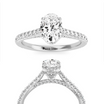
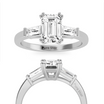
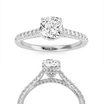
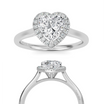
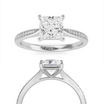
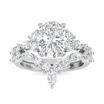


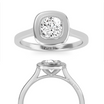
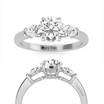
Leave a comment
This site is protected by reCAPTCHA and the Google Privacy Policy and Terms of Service apply.